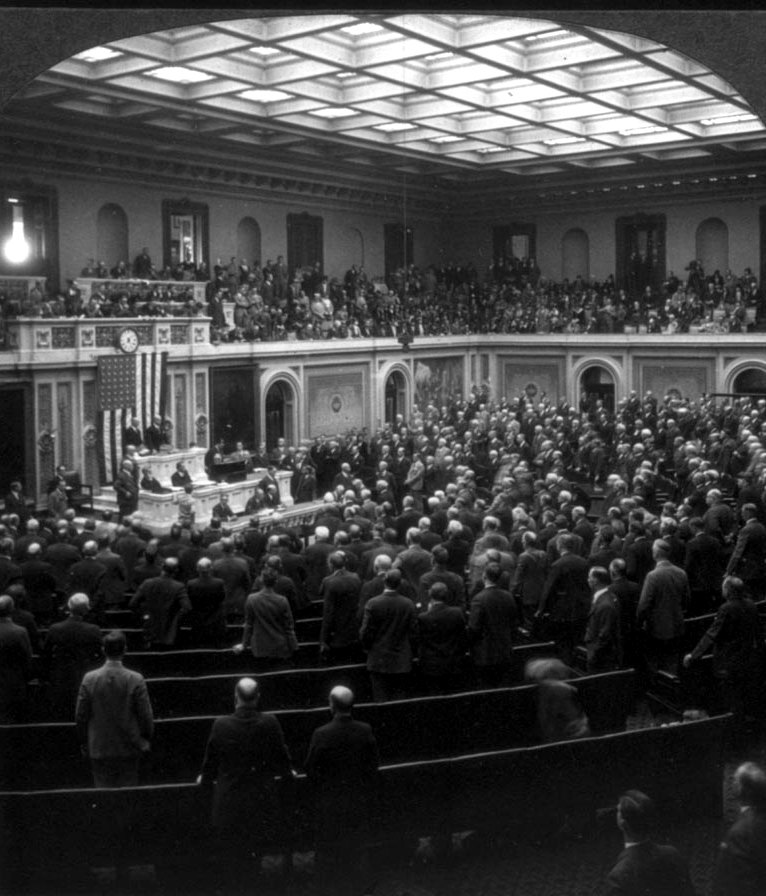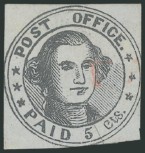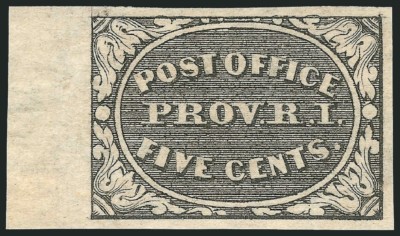By the 1840s, the postal system in the U.S. was chaotic. Virtually any entrepreneur could carry mail and charge any rates they could collect. Congress had, so far, failed to set standard rates and adopt postage stamps as the British had in 1840 and this led the business community to seek alternative solutions. Local posts quickly filled in the gaps of postal service and delivery, but these were operational only in individual states or even cities. They were “local” as the word implies.

It would not be until the Act of March 3, 1845 that Congress would finally lower postage rates and standardize them. A letter weighing up to one-half ounce could now be sent any distance up to 300 miles for 5¢ and more than 300 miles for 10¢. It would take another two years before the Postmaster General could print and issue uniform postage stamps for sale to the public. At last, on March 3, 1847, Congress authorized the Postmaster General to issue stamps.
The British postal reform was of much interest, however, the U.S. Post Office Department was slow to act in adopting reform. Congress was slow to enact postal rates and postage stamps with the result that private companies arose in major cities, distributing mail at lower than government rates. The Post Office Department was to later benefit from these private local posts’ successes and failures by learning from what had gone before. The pressure of the press and the public both demanding faster and more frequent service forced independent action from outside the Post Office Department.
Congress finally enacted the Act of March 3, 1845 (standardizing postal rates). March 3, 1847 marked the Postmaster General authorizing production of uniform postage stamps for sale beginning July 1, 1847. But until then, postmasters in several locales funded, prepared and sold what are called “postmasters’ provisional” stamps to the public. The rates charged were higher than the uniform rates of 5¢ and 10¢ set by Congress in order to pay for the dies, printing, paper, ink and labor to make the stamps. The drop rate was 2¢ and prepayment was optional. These postmasters met the public demand by preparing adhesives (or stamps), paying the expenses and selling them to the public for reimbursement at a price sufficient to meet costs and the legal postal rate.
The basis for the postmasters’ provisionals occurred when the owner of the private City Despatch Post was named a carrier of the New York Post Office. In the private post business since February 15, 1842, Alexander M. Greig had printed and issued stamps at a discount for 100 or more. In August, 1842, the New York City Post Office purchased Greig’s business and operated it as the United States City Despatch Post. The U.S. City Despatch Post issued the first adhesive stamp in the Western Hemisphere. Other locations soon followed suit.
Produced by Rawdon, Wright, Hatch & Edson using the Perkins mill and die process, the Postmaster of New York City, Robert H. Morris, sold many stamps he had authorized beginning on July 14, 1845 at the General Post Office & Branch at the Merchant Exchange on Wall Street. Morris had 60 employees and was in competition with more than a dozen local posts and three independent mail carriers. The New York model led other postmasters to step up.
Though the postmasters’ provisional stamps were legal only within the boundaries of each city’s postal system, New York City sent “a few” to other cities to be applied to mail destined for New York City. Even though the postmasters’ provisional stamps were not mandated by law, they did bear a unique official status. President James K. Polk and Postmaster General Cave Johnson were fully aware of the postmasters’ actions. The stamps were issued by government officials who were not precluded by law from acting as they did in the government’s (and their own) interests.
Other major locations that circulated postmasters’ provisional stamps were Alexandria, Virginia; Providence, Rhode Island; Brattleboro, Vermont; Baltimore, Annapolis and other Maryland locations; New Haven, Connecticut; Philadelphia and other locations in Pennsylvania; St. Louis, Missouri; Tuscumbia, Alabama; locations in Massachusetts, Florida, New Hampshire and Ohio; Washington, D.C. When the U.S. Post Office Department began to sell uniform U.S. stamps on July 1, 1847, postmasters’ provisional stamps were rendered invalid.

The postmasters’ provisional stamps range from quite primitive to rather refined, at least for their era.With the oldest of the provisional stamps approaching 175 years of age, it is not surprising that they are quite rare and highly valued by many collectors. The New York Postmaster Provisional had the most skillful appearance, being professionally produced by Rawdon, Wright, Hatch & Edson. Other provisionals are almost comical in their crude rendering.

While every postmasters’ provisional issue comes with a story, there are two worth mentioning specifically. Both the New York and the Providence, Rhode Island stamps are so well documented that an entire narrative can be presented and verified for their major varieties. The aforementioned Robert H. Morris, Postmaster of New York City, was a taskmaster when it came to recordkeeping and that is why we know so much about his wonderful George Washington stamps. We can even point out which of Morris’ assistants initialed a particular stamp. However, Postmaster Welcome B. Sayles, of Providence, Rhode Island, is not to be outdone. The elegantly beautiful Rhode Island stamps took a humorous turn after they had been invalidated and a letter carrier noticed a pile of them waiting to be incinerated.
Chat with your philatelic consultant about postmasters’ provisional stamps. Their active life was short, but fascinating, and we are fortunate to have so many facts about them.